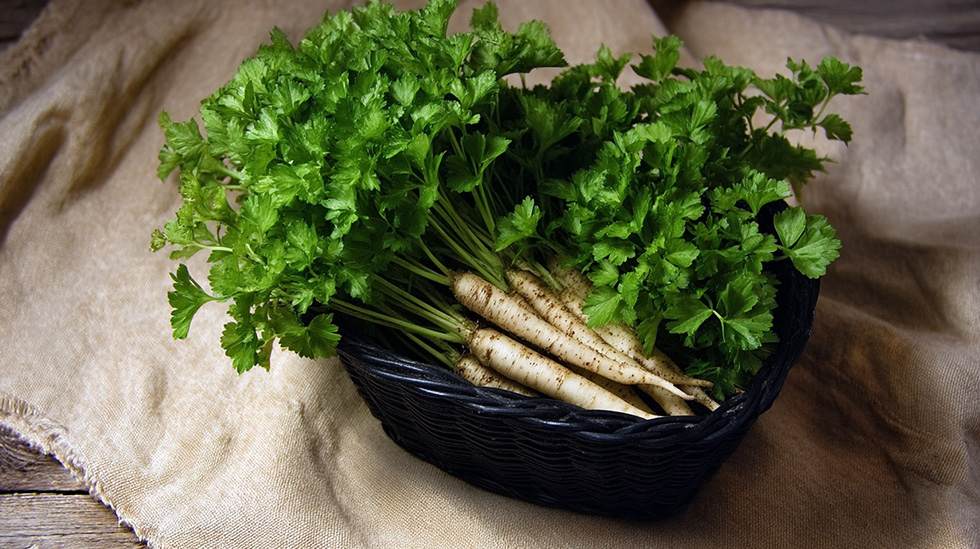Parsley root – The secret weapon of soups 🥕✨
The parsley root (Latin: Petroselinum crispum var. tuberosum ) is a really underrated but all the more important vegetable in Hungarian cuisine. It is often confused with parsnips, but they are not the same! It is also known as root parsley or turnip, although the latter name can be a little misleading as it is not the classic turnip.

It has been grown in Europe since the Middle Ages and originates from the Mediterranean region. It was known to the ancient Romans and, according to some sources, was even consumed as an aphrodisiac – although today it is more the hot chilli that does the trick 😄
Level of importance in the kitchen: 4/5
In Hungarian cuisine, the basis of soups is almost unimaginable without it: meat soup, vegetable soup, casserole soup – all of them call for parsley root. Although it is rarely in the limelight on its own, its flavour is a subtle influence on the character of the dishes. So it definitely deserves a solid four!
Edible parts of the plant
There are two main varieties of parsley: those grown for their leaves (chives) and those grown for their roots – in this case the latter.
- Edible part: the root, which is slender, light, ivory-coloured and often resembles a carrot. Excellent raw, cooked or fried.
- It is also edible: the leaves are edible, although not as juicy as the chopped variety. It is used more for decoration or flavouring.
- Inedible part: the seeds of the plant can be poisonous in large quantities and are not recommended for consumption.
Health benefits
Parsley root is not only tasty, it’s good for you! It’s rich:
- Vitamin C – strengthens the immune system
- Iron – helps blood formation
- Folic acid – particularly important for pregnant women
- Fibre – supports digestion
According to traditional medicine, it has a diuretic effect and can also relieve urinary complaints. And its antioxidant content supports detoxification.
Growing, season, origin
Parsley roots are grown in the open air, are not planted and are usually propagated by sowing. In our country it is mainly sown from spring to late summer and harvested from autumn until frost.
It has a long tradition of cultivation in Hungary, especially in the Southern Great Plain. Germany, the Netherlands and Poland are among the largest producers in the European Union. In Hungarian shops, from September to March the product is typically domestic, while in the other months it is imported (mainly Italian or Spanish).
How to choose good quality parsley roots
When buying, you should pay attention to the following points:
- Colour: should be a light, even ivory shade
- Touch: hard, firm, not rubbery or spongy
- Surface: smooth, free of cracks, no brown spots or mould
- Aroma: should have a pleasant, slightly spicy, earthy scent
Storage tips
If you store it in the fridge, wrapped in a damp tea towel or paper towel, it will stay fresh for up to 2-3 weeks. Deep-freezing is also an option – peel, slice and freeze. This way you’ll always have a little flavour bomb on hand for your soup! 😉
Parsley root in the big world
Although it is most common in central Europe, it is also used in French cuisine, for example as part of a “mirepoix” (carrot, onion, celery), where it is the base for broths and sauces.
It is less common in Middle Eastern cuisine, but is an essential ingredient in many vegetable soups and purees in Germany and Austria. In the Anglo-Saxon world, however, many people confuse it with parsnips – but we know the difference, don’t we? 😄
Recipe recommendation – Classic Hungarian vegetable soup
Ingredients:
- 1 parsley root
- 2 carrots
- 1 small kohlrabi
- 1 small celery
- 1 small head of onion
- 1 clove garlic
- salt, pepper, parsley
- 1 tbsp oil or butter
Preparation: dice the cleaned vegetables, fry them in oil in a pan and add water. Season and simmer for 25-30 minutes. Serve with fresh parsley greens at the end. Light, tasty and heart-warming!
Kitchen tips and seasoning
Parsley root goes well with the following spices:
- pepper
- nutmeg
- garlic
- thyme
- tarragon
Avoid strongly dominant spices such as curry or smoked paprika, however, as they can overpower the delicate, sweet taste.
You can use it in soups, purees, roasted vegetable mixes or even as chips in the oven. Drizzle with a little olive oil, season with salt and sprinkle with rosemary for a heavenly crunch!
Summary
Parsley root is not garish, not showy, but essential. It is a hero of everyday cooking, and one to be treasured. The next time you see it in the market, think of it as a secret ingredient that can spice up any dish – even your own! 🌿💚
